Pet Bird Essentials: Care and Enrichment Guide

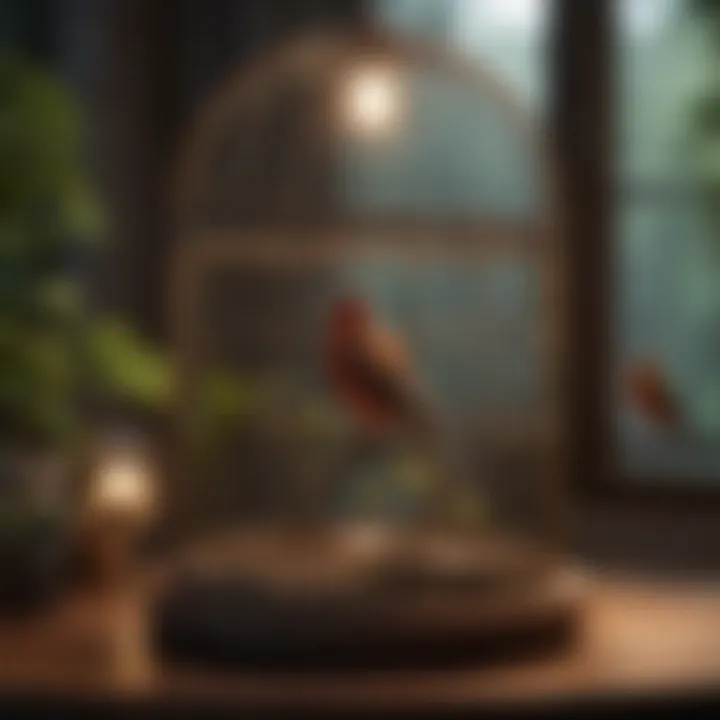
Intro
Birds have captivated humans for centuries, serving as both companions and symbols of freedom. Today, they are among the most loved pets worldwide. Owning a bird can bring joy and variety into life. However, bird ownership demands significant responsibility and knowledge. This guide provides an in-depth understanding of essential elements that contribute to the care and enrichment of pet birds. Whether you are a seasoned bird owner, a newbie, or a bird breeder, this guide offers insights that help you ensure your feathered friends thrive.
Care Tips
Daily Care Routines
Daily routines play a fundamental role in the overall well-being of pet birds. These routines typically include tasks like feeding, cleaning, and social interaction. A consistent schedule helps birds feel secure and content. Ensure your birds have access to fresh food and clean water each day. It is also important to interact with them daily. This can be through talking, singing, or simple playtime.
Cage Setup and Maintenance
The cage is the bird’s primary home, and proper setup is crucial. It should be spacious enough to allow movement and exercise. Choose appropriate perches, food and water dishes, and toys to keep the environment stimulating. Regular maintenance involves removing waste and uneaten food, as well as cleaning the cage to prevent bacteria buildup. Make sure to use bird-safe cleaning products.
Hygiene and Cleaning Practices
Maintaining hygiene in a bird's living area is essential for their health. Daily cleaning routines include wiping down surfaces and changing bedding materials. Weekly deep cleaning allows for a thorough disinfection of the cage, toys, and perches. This step significantly reduces the risk of diseases and parasites.
Seasonal Care Adjustments
Birds may require different care as seasons change. In warmer months, ensure they have access to shade and fresh air. Conversely, in colder months, provide adequate warmth. Adjusting light exposure can also be vital. Birds need a regular light cycle, and during winter, you must consider artificial light sources to maintain their health.
Behavioral Insights
Understanding Bird Body Language
Birds communicate largely through body language. Recognizing signs of contentment or distress can greatly enhance your bond with them. For instance, a relaxed posture, fluffed feathers, and soft vocalizations indicate a happy bird, while pinned eyes or tail flaring suggest stress or discomfort.
Common Behavioral Issues and Solutions
Behavioral challenges can arise in pet birds. Common issues include excessive screaming, feather plucking, or aggression. Identifying the root cause is necessary to address these problems. Often, providing more social interaction, enrichment, or adjusting their environment can lead to improvement.
Positive Reinforcement Techniques
Utilizing positive reinforcement can encourage desired behaviors. Offer treats or praise when your bird displays good behavior. This method works effectively for training tricks or routines, fostering a trusting relationship between you and your bird.
Social Interaction Needs
Birds are highly social creatures. It is crucial to provide them with ample opportunities for interaction. Whether it is through human contact or another bird, socialization can reduce stress and promote mental well-being. Consider scheduling regular playtime outside the cage to facilitate interaction.
Nutrition Guides
Essential Diet Components
A balanced diet is vital for a bird's health. This typically comprises a mix of seeds, pellets, fruits, and vegetables. Different bird species may have unique dietary needs, so research specific requirements for your bird type.
Safe and Toxic Foods
Knowing which foods are safe or harmful to your bird is important. For instance, most fruits and leafy greens are safe, while avocado and chocolate are toxic. Always consult reliable resources for a comprehensive list of bird-friendly foods.
Supplements and Treats
Occasionally, you may consider adding supplements to the diet. Vitamins and minerals can support overall health. However, limit treats to avoid overfeeding. They should complement a balanced diet rather than replace it.
Feeding Strategies for Different Species
Feeding approaches may vary based on the species. Some birds require more pellets, while others thrive on seeds. Tailoring the diet to meet specific needs can ensure better health outcomes.
Wellness and Health
Routine Health Checkups
Regular vet visits are crucial for maintaining your bird's health. These checkups help identify potential health issues early. Your veterinarian can provide guidance on vaccines and treatments necessary for various birds.
Identifying Symptoms of Illness
Awareness of common illness symptoms is critical. Changes in eating habits, lethargy, or altered droppings can indicate health issues. Prompt action is essential if any changes are observed.
Preventative Care and Vaccinations
Preventative care forms the backbone of a bird’s health regimen. Stay informed about necessary vaccinations specific to your bird species. Implement measures to keep their environment clean and free of parasites.
Mental and Emotional Well-being
Birds experience emotional health much like humans. Providing stimulation through toys, interaction, and varying their environment helps reduce stress. This fosters a happier and healthier life.
Enriching Activities
Toys and Playtime Ideas
Toys should be engaging and safe. Rotate toys regularly to maintain interest. Include items that encourage beak and claw exercise. For instance, natural wood chews can provide both entertainment and dental care.
Training and Tricks
Training birds can be a rewarding endeavor. Basic commands or fun tricks stimulate their minds and strengthen bonds. Use patience and positive reinforcement for better results.
Outdoor Activities and Interaction
If safe, consider taking your bird outdoors. Fresh air can boost their mood and overall well-being. Ensure they are securely harnessed or caged while outside to avoid risks.
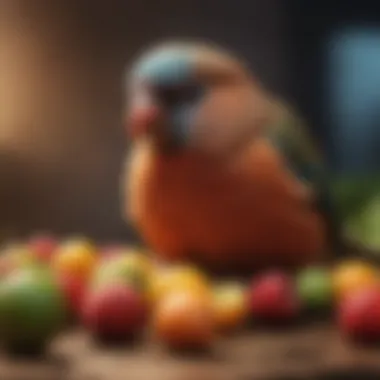

DIY Projects for Mental Stimulation
Creating DIY projects can offer mental engagement for birds. Simple tasks like building toys or creating habitats can stimulate their natural instincts and make their environment dynamic.
Investing time and effort in understanding your bird's needs translates to a richer and happier relationship for both of you.
Understanding the Needs of Pet Birds
Caring for pet birds requires an in-depth understanding of their unique needs. Each species has different requirements that influence their overall well-being. This section provides an overview of these fundamental aspects, ensuring that avian enthusiasts are well-equipped to meet their feathered friends’ demands for a fulfilling life.
Species-Specific Requirements
Small Birds
Small birds, such as budgerigars and finches, are often favored for their compact size and sociable nature. Their diminutive stature makes them ideal for small living spaces while still providing companionship. Typically, these birds thrive in environments where they have company, as many prefer to interact, especially in pairs. One must consider that while small birds are generally easier to maintain, they require sufficient stimulation and social interaction to prevent boredom. Enrichment activities are essential, and their playful nature can make owning them very rewarding. However, owners must be mindful of their delicate bones and avoid rough handling.
Medium Birds
Medium birds like cockatiels and lovebirds stand out due to their engaging personalities and vocalizations. They balance playful energy with a manageable size, making them suitable for many households. This group of birds tends to bond closely with their caregivers, often exhibiting affectionate behavior. In this manner, they provide emotional uplift and companionship. Nonetheless, the range of needs for medium birds can vary significantly, as they can be more assertive than small birds. Thus, regular interaction and dedicated playtime are necessary. Owners must pay attention to their social requirements and ensure they receive adequate mental stimulation through toys and activities.
Larger Birds
Larger birds, such as African greys or macaws, present a different set of challenges and rewards. These birds possess remarkable intelligence and can foster deep bonds with their owners. Their large size necessitates ample space, both in their cages and in their environment, making them better suited for those with larger homes. Their social nature means they generally want human interaction, requiring owners to be highly involved in their lives. However, larger birds can be demanding. They require more attention and may develop behavioral issues if not adequately engaged or socialized. Understanding these requirements is crucial in ensuring a harmonious relationship with them.
Physical and Emotional Health
Understanding Bird Behavior
Understanding bird behavior entails recognizing their natural instincts and actions. Birds can exhibit various behaviors that reflect their emotions and mental states. For example, a relaxed bird may preen or vocalize softly, indicating comfort. Conversely, an agitated bird might exhibit aggression or excessive feather plucking. Grasping these behavioral cues contributes significantly to their care. A well-socialized bird can lead to a happier pet and a more rewarding ownership experience. Moreover, being attuned to their specific needs aids in creating routines that align with their natural tendencies.
Signs of Distress or Illness
Recognizing the signs of distress or illness in birds is critical for maintaining their health. Birds are known to hide their ailments, so acute observation is vital. Common indicators of distress may include changes in eating habits, lethargy, or alterations in vocalization. A bird that flicks its wings or exhibits rapid breathing may be in discomfort. Regular monitoring encourages early detection of health issues, allowing prompt veterinary intervention. Understanding these signs can lead to more timely and effective care, fostering a better quality of life for the bird.
Choosing the Right Cage
Choosing the right cage for your pet bird is essential for both its well-being and your peace of mind. A cage serves as the primary habitat for a bird, providing it with a safe space to live, play, and rest. The right cage can enhance the physical and mental stimulation of your bird. Without the appropriate enclosure, you risk creating an environment that may lead to stress, behavioral issues, or health complications. Therefore, understanding your bird's needs, the various types of cages available, and how to select one that complements both your living space and your feathered friend's lifestyle is crucial.
Cage Size and Space Considerations
Dimensions for Different Breeds
When it comes to cage dimensions, different bird breeds require varying amounts of space. Small birds like budgies need a cage with a minimum size of 18 x 18 x 24 inches. In contrast, medium birds, such as cockatiels, benefit from cages measuring at least 24 x 24 x 36 inches. Larger breeds, like macaws, should have cages of at least 36 x 48 x 60 inches. These specific dimensions allow for necessary movements like flapping and climbing, which are important for a bird's health.
Choosing an adequately-sized cage reduces the risk of injury and promotes a sense of security. A cage that is too small can leave a bird feeling confined, leading to stress and abnormal behaviors. Conversely, a cage too large can struggle for smaller birds to find comfort.
Vertical vs Horizontal Space
Birds are naturally inclined to fly upward, so vertical space can be as crucial as horizontal space. Cages designed with height can help satisfy the climbing instincts of birds, thus enhancing their experience inside.
For species that are primarily ground feeders, horizontal space may be more necessary. However, most pet birds thrive better in cages that offer significant vertical room, allowing them to utilize perches at different heights. A cage design that incorporates both vertical and horizontal space is generally more beneficial. It allows for various activities, enhancing physical health and reducing monotony.
Material and Design Preferences
Types of Cages
Cages come in a range of materials, including metal, plastic, and wood. Metal cages, particularly those made of stainless steel or powder-coated wires, are often preferred because they resist chewing and are easier to clean. However, plastic cages are lighter and can be more affordable, but they may not last as long and could be prone to damage.
Choosing a high-quality cage material is a sound investment. It ensures durability and security for your pet. Different materials also have unique maintenance needs. Metal cages may require specific cleaning agents to avoid corrosion, while wooden cages may need treatments to prevent decay.
Aesthetic Considerations
While functionality is important, the appearance of the cage also plays a role in its selection. Cages come in various styles and colors to suit personal taste and decor. An attractive cage can act as a prominent feature in your home, linking aesthetics with the comfort of your pet.
However, aesthetic elements should not overshadow practicality. A cage that looks appealing but is difficult to clean, has poorly placed perches, or is made of unsuitable materials may not be the right choice. It's essential to blend looks with functionality while making your selection.
"A cage that balances beauty and function is key to a thriving bird environment."
Nutritional Guidelines
Nutritional guidelines are fundamental for the well-being of pet birds. A well-balanced diet can significantly affect a bird's health, behavior, and life expectancy. Different species have varied dietary needs, so understanding these requirements is critical. Appropriate nutrition not only supports physical health but also aids in developing a strong bond between pet birds and their owners.
Fundamental Diet Components
Seeds vs Pellets
When it comes to pet bird diets, the debate between seeds and pellets is a common one. Seeds are often seen as a traditional choice, while pellets are considered more modern and nutritionally complete. Seeds might be appealing due to their natural form and variety, but they can lack the essential nutrients required for a balanced diet.
Pellets are designed to provide comprehensive nutrition in a single source. They typically contain a mix of grains, vegetables, and added vitamins and minerals. One of the main advantages of pellets is that they prevent selective eating, which is common when birds are offered seeds. Birds can sometimes pick their favorite seeds, ignoring others that may not be as nutritious.
However, some owners still prefer seeds because they mimic a bird's natural foraging behavior, which can be enriching for the bird. The major downside is that a seed-only diet might lead to obesity or nutrient deficiencies if not properly managed.
Fresh Fruits and Vegetables
Inclusion of fresh fruits and vegetables in a bird's diet is crucial. These foods are rich in vitamins and antioxidants, which support a bird's immune system and overall health. Fresh produce can offer a variety of textures and flavors that stimulate a bird's curiosity and encourage natural foraging behaviors.
In particular, fruits like apples, berries, and bananas can provide essential nutrients and hydration. Likewise, vegetables such as carrots, leafy greens, and bell peppers can enhance dietary balance. The unique feature of fresh fruits and vegetables is their ability to offer diversity in a bird's diet, preventing boredom and promoting behavioral well-being. However, it is important to wash and prepare them properly, as some produce can be treated with chemicals that may be harmful to birds.
Dietary Supplements
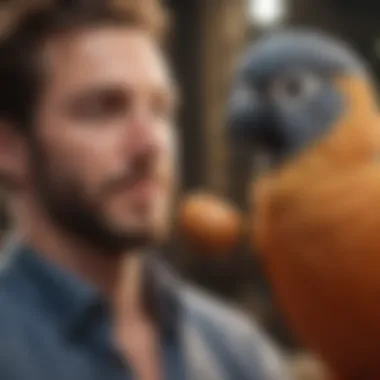
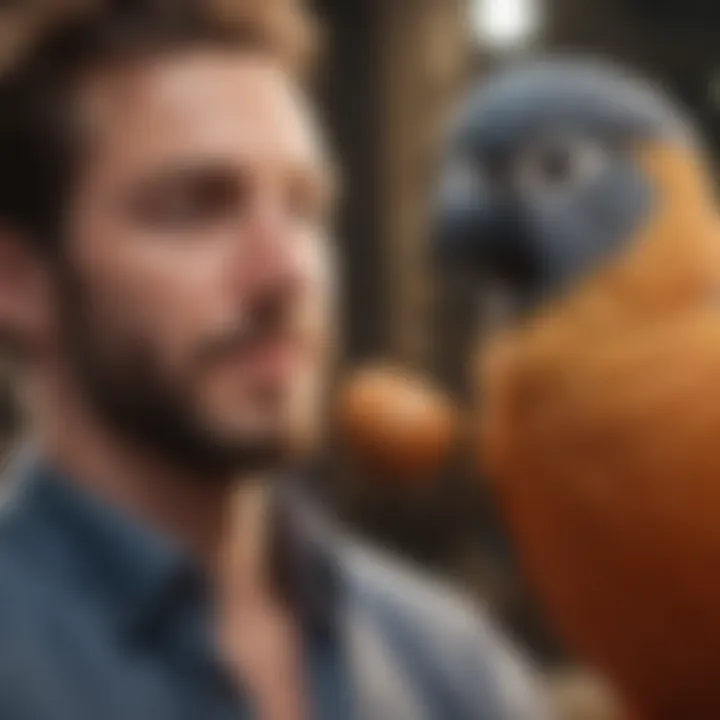
Dietary supplements can play a vital role in enhancing a bird's diet. Depending on the base diet, supplemental vitamins and minerals can help meet a bird's specific health needs. Supplementation should be considered carefully, as over-supplementation can cause imbalances.
Vitamins and Minerals
Vitamins and minerals supplement the diet by providing essential nutrients that might be missing from the standard food. Common supplements include Vitamin A, which is crucial for vision and immune function; calcium, which is needed for strong bones; and various B vitamins that support metabolic processes.
These supplements can be found in liquid, powder, or tablet form. The benefit of vitamins and minerals lies in their ability to boost overall health and prevent dietary deficiencies. However, it is essential to use them under guidance from a veterinarian to avoid potential risks.
Calcium Sources
Calcium is particularly important for birds, especially those that are breeding or laying eggs. Proper calcium levels are necessary for muscle function and bone health. Natural sources of calcium such as cuttlebone, crushed eggshells, and leafy greens should be part of the diet. Adding these sources can improve a bird's overall vitality and support its skeletal system.
It is also possible to find commercially available calcium supplements designed specifically for avian diets. While beneficial, it is crucial to balance calcium with other nutrients to avoid toxicity or digestive issues.
"Providing a well-rounded diet is a commitment but crucial for your bird’s long-term health and happiness."
A comprehensive understanding of nutritional guidelines helps pet bird owners make informed decisions. Focusing on seeds versus pellets, the importance of fresh produce, and nutritional supplements can greatly enhance the quality of life for avian companions.
Social Interaction and Enrichment
The significance of social interaction and enrichment for pet birds cannot be overstated. Birds are inherently social creatures. They thrive on interaction, both with their owners and, in some cases, with other birds. Providing social stimulation is vital to prevent behavioral issues and to promote a balanced, healthy life. When owners engage their feathered friends, they stimulate mental health, thus reducing stress levels and enhancing overall well-being.
Importance of Socialization
Bonding with Your Bird
Bonding with your bird encompasses creating a trustful relationship between avian and owner. Establishing this bond is key to building a comforting environment. A strong bond can contribute to a pet bird's emotional stability and create a more responsive companion. Birds that feel secure are more likely to engage in healthy behaviors.
Socialization activities can include talking, gentle petting, and training commands. This physical and emotional contact is essential for the bird's mental stimulation and security. Some birds are naturally inclined to bond quickly, while others might take more time; understanding this variability is crucial for success.
Benefits of Bonding:
- Increased trust can lead to a more interactive and engaging pet.
- A bird that feels secure is less likely to exhibit aggressive or fearful behavior.
Drawbacks:
- Poor bonding techniques can lead to fear or mistrust.
Introducing New Birds
Introducing new birds is a delicate process. It offers an opportunity for social growth and more robust mental stimulation. However, managing introductions requires careful planning. Gradual integration allows existing birds to adjust without feeling threatened. Each bird has its temperament and responding poorly can lead to stress or conflict.
Characteristics of Introducing New Birds:
- It allows for new social interactions.
- Birds can benefit from companionship, which can reduce feelings of isolation.
Advantages:
- A well-planned introduction can enhance the overall social structure of your household.
- Observing a new dynamic can be rewarding for the owner.
Challenges:
- Risk of aggressive behaviors if not managed properly.
Activities and Toys
Engaging birds in activities and providing appropriate toys is crucial for their enrichment. Birds need physical activities that mimic their natural behaviors. Toys encourage play, exploration, and cognitive development, which are central to a bird's well-being.
Toy Selection Guidelines
Selecting the right toys can enhance your bird's quality of life significantly. The importance of choosing appropriate toys cannot be overlooked. Diverse options should be available for birds to chew, climb, and explore. Toys made from safe, non-toxic materials ensure that your bird remains healthy. Regularly changing toys not only maintains interest but also challenges the bird mentally.
Key Points of Toy Selection:
- Safety: Ensure all materials are non-toxic.
- Variety: Provide different types to appeal to your bird's instincts.
Advantages:
- Mental engagement prevents boredom and stress.
- Encourages natural behaviors like climbing and foraging.
Potential Concerns:
- Some toys might be inappropriate if your bird is particularly small or large, leading to injury.
Creating an Enriching Environment
An enriching environment encompasses various factors that stimulate a bird’s mind and body. This involves strategic placement of toys, use of perches at different heights, and opportunities for foraging. Environmental enrichment should be tailored to the bird’s species and individual personality, providing ample opportunities for exploration and play.
Creating an Enriching Space:
- Introduce different species-appropriate toys and perches.
- Place items strategically to encourage movement and exploration.
Benefits:
- Promotes physical health through movement.
- Offers continual stimulation, reducing the risk of behavioral problems.
Considerations:
- Changes might disrupt a bird's routine, so gradual adjustments work best.
Enrichment and social interaction directly correlate with a bird's happiness. Pet owners should prioritize these aspects for a fulfilling life for their feathered companions.
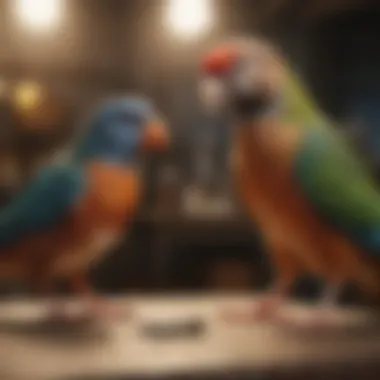
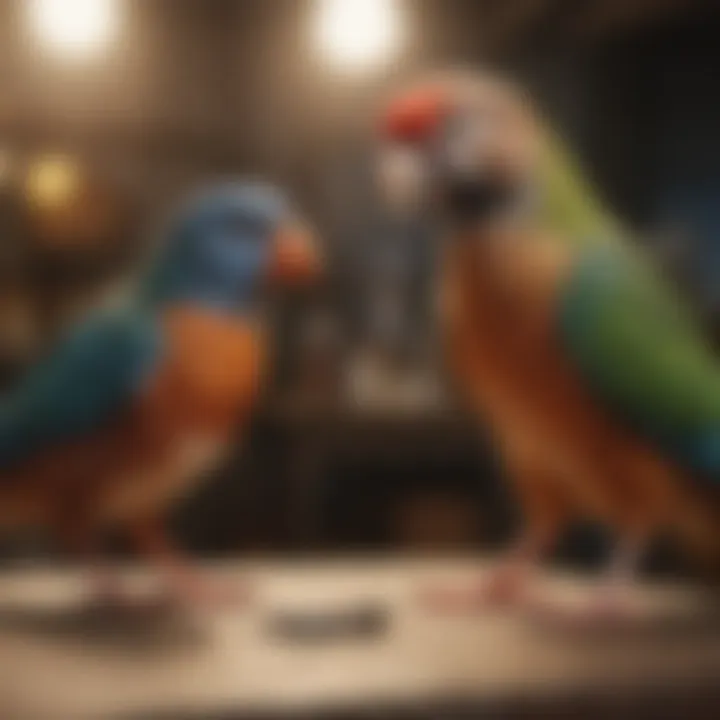
Health and Wellness Considerations
Ensuring the health and wellness of pet birds is vital for their longevity and happiness. Birds are delicate creatures that can easily succumb to a variety of health issues if not properly cared for. Given their unique physiology and behavioral patterns, understanding their specific health needs is crucial for every bird owner. A proactive approach not only benefits the birds but also strengthens the bond between the pet and the owner. Regular evaluations and timely interventions can prevent minor issues from escalating into serious problems, enhancing the overall quality of life for the bird.
Regular Veterinary Care
Choosing an Avian Veterinarian
Selecting the right veterinarian is essential for the well-being of a pet bird. An avian veterinarian specializes in birds and understands their unique health needs, unlike a general veterinarian. The key characteristic of a qualified avian vet is their specialization, which means they have training that equips them to diagnose and treat avian-specific diseases. It's beneficial to choose a veterinarian with a certification from the Association of Avian Veterinarians. This ensures they are up-to-date on the best practices for avian care. The unique feature of working with an avian veterinarian is their familiarity with various bird species, enabling more tailored treatments that benefit the specific needs of an individual bird.
Routine Checkups
Routine checkups are an indispensable part of maintaining the health of a pet bird. These checkups enable early detection of potential health concerns before they become acute. A significant characteristic of these evaluations is the comprehensive health assessment, which includes checking the bird's weight, feathers, and overall demeanor. Routine checkups are beneficial as they help in monitoring any changes in the bird’s health over time. Avian veterinarians often provide invaluable guidance on nutrition, housing, and behavioral health during these visits. The unique feature of such regular visits is that they help foster a strong ongoing relationship between the bird and the vet, ensuring that the bird receives consistent care over its lifetime.
Prevention and Treatment of Common Issues
Parasites
Parasites can pose severe threats to the health of pet birds. These can include ectoparasites like mites or lice and internal parasites such as worms. They are critical to address because they can cause significant discomfort and can lead to serious health complications if not treated promptly. Identifying the signs of a parasitic infestation, such as excessive scratching or changes in droppings, is essential for early intervention. Treatment typically involves medication prescribed by a veterinarian. Understanding this aspect of bird care is beneficial because early prevention can save birds from extensive suffering and costly treatments later.
Respiratory Issues
Respiratory issues in birds are common but can have serious consequences if not addressed properly. Birds are sensitive creatures, and their respiratory systems can be affected by various factors, including poor air quality, exposure to irritants, and infection. The key characteristic of respiratory issues is that they can often be subtle, making them difficult to detect until they become severe. Symptoms may include labored breathing, changes in vocalizations, or excessive sneezing. It is crucial to maintain a clean environment, free from dust and potential allergens. Addressing these issues early is beneficial as it can prevent hospitalization and more invasive treatments. Understanding how to create a healthy living environment is vital for any bird owner, ensuring that the pet thrives in its home.
Creating a Safe Environment
Creating a secure environment for pet birds is not only important for their physical well-being but also for their mental health. Birds are naturally curious creatures and will explore their surroundings. This tendency means that their living spaces must be devoid of potential dangers. Hazards in the home can lead to injury or even fatal accidents. Thus, it is essential for bird owners to be proactive in managing their environments. This section provides valuable insights into the types of hazards that can exist in a home and how to mitigate them for the safety of your avian companion.
Identify Hazards in Your Home
Household Chemicals
Household chemicals are a significant concern when creating a safe environment for pet birds. Many everyday items, such as cleaners, detergents, and pesticides, contain harmful substances. Birds have a unique respiratory system that can be particularly sensitive to these chemicals. Even those products that seem harmless to humans can prove toxic to birds, sometimes causing respiratory issues or other serious health problems. Therefore, it is crucial to ensure that these chemicals are stored safely out of reach.
A key characteristic of household chemicals is their potential for vaporization. Many chemicals release fumes that can linger in the air. Birds can inhale these fumes, leading to respiratory distress. In addition, some cleaning products may create residues on surfaces that can be harmful when ingested. Awareness of these risks is essential to prevent accidental exposure.
Advantages of avoiding household chemicals include reducing health risks for your pet and creating a healthier living environment for everyone. The unique feature here is that using safer, non-toxic alternatives can effectively maintain cleanliness without endangering your bird's health. Owners might consider vinegar or baking soda as safer cleaning options, but it is wise to double-check any product's safety beforehand.
Unsafe Furniture and Fixtures
Unsafe furniture and fixtures represent another source of hazards in your bird’s environment. Many common furniture items contain materials or designs that may pose risks. For example, wooden furniture treated with varnishes or paints may emit harmful substances. Birds often chew, so it is important to consider whether furniture poses ingestion risks.
A noteworthy feature of unsafe furniture is sharp edges and small parts. Birds may accidentally injure themselves on sharp corners or swallow small components, leading to choking or internal damage. It is beneficial, therefore, to inspect furniture and make necessary adjustments to protect your pet. Securing loose cords or placing heavy items out of reach can help create a safer space.
Outdoor Safety Measures
Outdoor activities can greatly benefit pet birds, but safety must be the first priority. Providing a secure outdoor experience requires thoughtful planning to protect your feathered friend from potential risks.
Supervised Outdoor Time
Supervised outdoor time is an excellent way to enrich your bird's life. This activity allows birds to enjoy fresh air and natural sunlight while remaining secure. The key characteristic here is that supervision significantly reduces the risk of escape or encounters with predators. Birds in nature frequently face threats from other animals, so outdoor experiences must be carefully managed.
A unique feature of supervised outdoor time is the use of harnesses or secure cages. These tools can allow birds to experience the outside world safely. The advantage is that they get much-needed mental stimulation by observing their outdoor environment. In contrast, unsupervised outdoor time could lead to injury, loss, or even permanent dangers, so the benefits of supervision clearly outweigh the potential risks.
Building a Safe Aviary
Building a safe aviary is another effective option for providing outdoor experiences. Such an enclosure allows birds to enjoy outdoor space freely while being protected from predators and other hazards. A well-designed aviary should include features such as sturdy materials, proper ventilation, and safe access to sunlight and shelter.
A distinctive aspect of aviaries is the opportunity for social interaction. Birds housed in an aviary can interact with other birds, which can enhance their social skills and overall well-being. The advantage of this setting is that it mimics a more natural environment, allowing birds to express their instinctual behaviors. However, careful planning in design and placement is necessary to ensure long-term safety and protection.
To sum up, both supervised outdoor time and aviaries present valuable opportunities for pet birds. Nonetheless, these options require careful consideration and adequate safety measures to maximize benefits without exposing pets to risks. Proper planning can lead to a fulfilling outdoor experience for both the bird and its owner.
Traveling with Pet Birds
Traveling with pet birds is an essential aspect for any avian enthusiast. Birds are sensitive creatures, and changes in their environment can induce stress or anxiety. Understanding how to travel safely with birds ensures their well-being while maintaining a harmonious relationship with the owner. Whether journeying for vacations or relocations, careful preparation is vital.
Preparing for Travel
Suitable Travel Cages
When selecting a travel cage for your bird, the cage must be both secure and comfortable. This characteristic is crucial since it helps maintain a sense of safety for the bird during transit. A suitable travel cage should fit the bird snugly but offer enough space for movement. This balance is beneficial because it minimizes stress and allows the bird to adapt to the confined environment.
Many travel cages feature robust latching mechanisms to prevent accidental escapes. Additionally, some may include seamless designs that reduce stress by eliminating sharp edges. While typical cages may not be easy to carry, choosing a lightweight model makes transportation simpler while safeguarding the bird's comfort throughout the journey. Look for cages that allow for the inclusion of familiar toys or perches, as these can provide much-needed security.
Hydration and Nutrition During Travel
Ensuring proper hydration and nutrition is critical during travel. Birds can become dehydrated quickly, especially in unfamiliar settings. Therefore, offering water in secure containers helps maintain their hydration levels. It is important that this characteristic remains a focal point, as water accessibility is fundamental to their health.
In addition to water, preparing small amounts of their regular food can help to provide comfort and familiarity. Seed mixes or pellets can be ideal options; however, avoid fresh food that may spoil during long trips. This unique feature becomes essential to prevent health risks associated with spoiled food. Essentially, understanding these needs before departure is imperative for a successful travel experience.
Adapting to New Environments
Minimizing Stress
Minimizing stress during the travel experience is crucial for the mental and physical health of pet birds. Birds can react negatively to drastic changes, leading to unwanted behaviors. One method is to keep the travel cage covered during the journey. This action creates a sense of security, reducing external stimuli that may frighten them. This characteristic of stress reduction offers a straightforward solution to making any travel event smoother.
It can be beneficial to speak softly to your bird throughout the travel period, reassuring it that all is well. Using calming words or quiet music may also help in alleviating anxiety. The presence of a trusted companion in the travel space can provide a familiar face and further minimize stress.
Establishing a Routine
Establishing a routine during travel is another vital element for keeping the bird calm. Birds thrive on patterns; thus, being consistent with feeding times and care routines can lead to less anxiety. This characteristic is beneficial, as it lets the bird know what to expect, increasing its comfort level in the new environment.
When possible, maintain a similar schedule to what your pet is used to at home. This includes regular intervals for feeding and social interaction. Incremental adaptation to changes can help facilitate this process, making transitions smoother.
Keeping a consistent routine during travel can significantly ease the burden of adaptation for pet birds.















